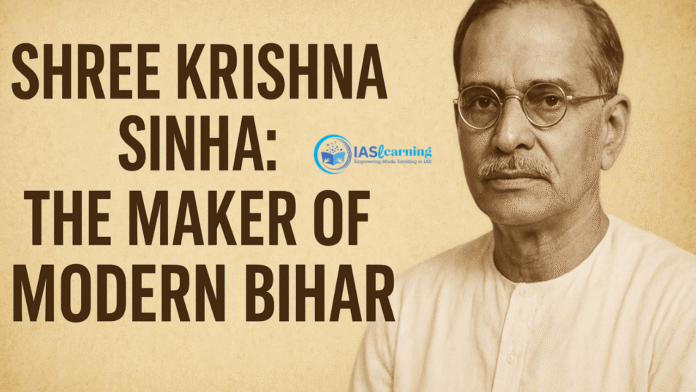Introduction
As Bihar heads toward its Assembly elections, it’s worth remembering the leaders who built its political foundations. The story begins with Shree Krishna Sinha, also known as “Shri Babu” or “Bihar Kesri”, who became Bihar’s first Chief Minister and ruled for over 17 years. His leadership laid the foundation of modern Bihar — from ending zamindari to starting industrial reforms.
Early Life and Entry into Freedom Struggle
- Born: 1887, in Maur (now Sheikhpura district, Bihar)
- Background: A Bhumihar by caste, lawyer by profession
- Joined the Freedom Struggle: Inspired by Mahatma Gandhi, he gave up law to join the Non-Cooperation Movement (1921).
- Prison Life: Spent about 8 years in jail for his nationalist activities.
- Social Reformer: Fought for Dalit temple entry at Shri Baidyanath Dham, Deoghar (Jharkhand).
Rise in Politics
Before Independence, the Bihar Pradesh Congress Committee (BPCC) was full of internal divisions — mainly between Kayasthas, Bhumihars, and Rajputs. Despite this, Shree Krishna Sinha emerged as the most respected leader due to his Gandhian values and organizational skills.
After the 1937 elections, the Muslim Independent Party’s Mohammad Yunus briefly became Premier, but soon Congress took charge.
Sinha became Premier of Bihar (1937–39), and later Chief Minister (1946–61) with Anugrah Narayan Sinha as his trusted deputy.
Read More: India to Host Commonwealth Games 2030
First Elections and Governance
In 1951–52, the first Assembly elections were held in Bihar:
- Voter turnout: 39.51%
- Total Assembly seats: 330
- Congress victory: 239 seats
With overwhelming support, S K Sinha was unanimously chosen as Chief Minister.
Major Reforms and Achievements
1. Zamindari Abolition Act, 1949
- Bihar became the first Indian state to abolish the zamindari system.
- The Act aimed to end landlord control and redistribute land to farmers.
- However, poor implementation led to unrest and the later rise of Naxal movements.
2. Food Security Efforts
- Launched the “Grow More Food” campaign (1948) to tackle food shortages.
3. Industrial and Infrastructure Development
Under his leadership, Bihar took major steps toward modernization:
- Foundation of Bokaro Steel Plant and Bokaro Steel City
- Barauni Refinery, Heavy Engineering Corporation (Ranchi), and fertilizer plants
- Development of coal belts like Jharia
- Construction of Rajendra Setu (Simaria Bridge) — the first bridge connecting North and South Bihar
4. Stability and Strong Leadership
While neighbouring states like UP saw multiple leadership changes, Sinha’s long tenure ensured political stability and development continuity.
He remained in power till his death in 1961, at the age of 73.
Legacy and Contribution
- S K Sinha’s tenure remains one of the longest in Bihar’s history, surpassed only by Nitish Kumar in 2023.
- His leadership laid the foundation for Bihar’s industrial and agricultural growth.
- Remembered as a visionary, reformer, and nationalist, he continues to inspire Bihar’s political landscape.
Quick Facts for UPSC/BPSC
| Topic | Details |
|---|---|
| Full Name | Shree Krishna Sinha |
| Born | 1887 (Maur, Sheikhpura, Bihar) |
| Died | 1961 (while in office) |
| Popular Titles | Shri Babu, Bihar Kesri |
| Political Party | Indian National Congress |
| Deputy CM | Anugrah Narayan Sinha |
| Key Reforms | Zamindari Abolition Act (1949), Grow More Food Campaign |
| Major Projects | Bokaro Steel Plant, Barauni Refinery, Rajendra Setu |
| Tenure as CM | 1946–1961 (17+ years) |
| Legacy | Maker of Modern Bihar |
PYQs (Previous Year UPSC/BPSC Questions)
- Discuss the role of Shree Krishna Sinha in post-independence Bihar’s development.
- Explain the importance of the Zamindari Abolition Act of 1949 in Bihar.
- Who was known as the “Bihar Kesri” and why?
- Which leader is known as the first Chief Minister of Bihar?
- What were the major industrial projects initiated during S K Sinha’s tenure?
Conclusion
Shree Krishna Sinha’s leadership shaped the destiny of Bihar. His vision of equality, self-reliance, and development made him the true maker of modern Bihar. Even decades after his passing, his ideals of governance, integrity, and service remain relevant for India’s democracy.
Read More: Telecommunications (Telecom Cyber Security) Amendment Rules, 2025

